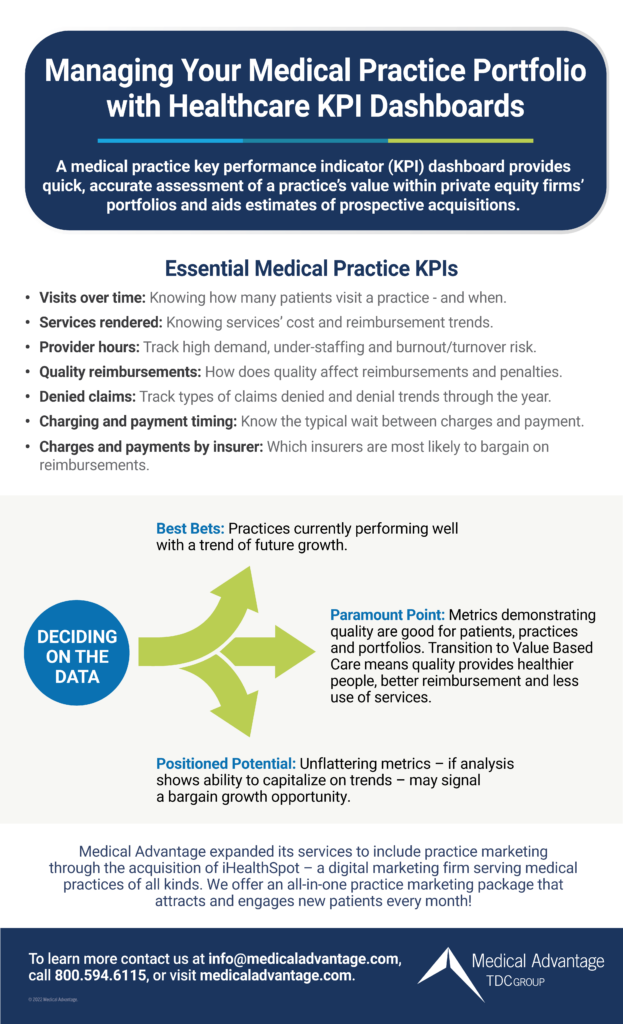A medical practice key performance indicator (KPI) dashboard provides a quick and accurate assessment of a practice’s value within private equity firms’ portfolios as well as the estimated worth of prospective acquisitions as healthcare growth continues.
Investors currently hold $1.8 trillion dollars in healthcare investments, and healthcare providers are attractive acquisitions for multiple reasons. The healthcare sector, unlike most investment opportunities, is growing at a faster rate than the gross domestic product (GDP) in the United States, according to the Journal of Health and Life Sciences Law.
Private equity investors consider healthcare demand effectively recession-proof since the need for healthcare is less sensitive to market conditions than other goods. Demand is not only expected to weather downturns well but it is also projected to continue growing as a rising percentage of the country’s population ages into their golden years.
But even within an industry widely assumed to be a sound investment, there are degrees of presumptive safety and exceptions to the rule. The devil remains in the details, which run the gamut from fragmented business units, complex policies or legislation, multiple locations, data silos, and faulty reporting processes.
In a recent Medical Economics interview, Rick Zall, an attorney, and chair of Proskauer’s healthcare group said private equity firms are looking for platform practices — operations that will act as a staging center for growing a larger practice. Prospective practices will need multiple locations and enough revenue and profit so that the new owners can build on them. Not only will these firms be looking at if the practice is making money, but also how it is making this revenue. Healthcare performance metrics delivered via dashboards can provide such insights at your fingertips.
Medical Practice KPI dashboards provide powerful, all-in-one views into practice performance shining a comprehensive, multi-layered light into the business health of medical practices. The software also provides easy analytics across multiple practices, allowing benchmarking for faster, more informed decision-making.
The Challenges of Data Analysis Across Practices
Data silos are separate databases of information not part of an organization’s enterprise-wide data management system. Since the data is in a separate location from the main network, management reports become unnecessarily complicated and information is often duplicated. Electronic Health Records (EHRs), payroll systems, and scheduling software are all examples of systems that may silo vital information away from a single source of truth and easy assessment.
Siloed data adds steps to the process of creating a complete picture of a medical practice’s business operations. Scheduling and appointment data that is not included in revenue and billing reporting limits the context required to assess revenue trends, for instance. This is a problem since the “value” in value-based care comes from measuring health outcomes against costs.
Healthcare entities have to know that the data used for measuring quality, finance, and performance are prompt and accurate, according to Margaux Gleber of Veta Health. Silos prevent practices and private equity firms (that own portfolios full of practices) from taking full advantage of big data with healthcare analytics.
“Beyond in-person treatment aggregated health data leads to advancements in medications, treatments, and processes that ultimately saves lives,” Gleber wrote.
Pulling that data from its silos into a comprehensive look at a practice’s operations using healthcare analytics requires extra time and resources, an impractical approach for practice staff and executives. But medical practice KPI dashboards can perform that work automatically, saving healthcare providers time and improving the precision of data collection.
Dashboards are not solely useful in assessing single practices as silos can also develop among groups of practices. Healthcare dashboard metrics can be used to assess the health and trends of your whole portfolio. Dashboards can dig through data across multiple practices, integrating various systems and practices into a single dashboard—or set of dashboards— with multiple reports and virtually unlimited metrics to support the need of the practice.
Dashboard customization is another essential element to bear in mind. Customizability is crucial to the successful rollout of any dashboard solution, and arguably the most important dashboard element when it comes to breaking down your data silos.
Essential KPIs Medical Practices Need to Watch
Medical Practice KPI dashboards provide a wealth of data about your medical health practice, but some metrics are more important than others.
- Visits over time: How much traffic do practices get? What is the practice’s number of patients? Accurate information about how many patients visit a practice – and how often – is essential to maintaining and growing volume.
- Services rendered: What services are popular across practices? How are they trending? Knowing whether services are low cost and high reimbursement or high cost and low reimbursement, and where those trends are heading, is a key element in assessing a practice.
- Provider hours: How much are your providers working? Knowing this will indicate under-staffing and a risk of burnout and high turnover.
- Quality reimbursements: How are your quality metrics performing and how is this affecting reimbursements and/or penalties? Determining the overall quality of your care will aid your patients, and, increasingly, your bottom line.
- Denied claims: Keep an eye on denied claims, and work to resolve them. Identifying trends in the types of claims denied and any fluctuation during specific months will be helpful in determining how to limit future claim denials. Denied claims are expensive and wasteful, so if a specific code is repeatedly entered erroneously, or a similar pattern emerges, you will be able to plan a data-driven solution.
- Time between charges and payments: A data graph showing long gaps between charges and payments are not necessarily a sign of a healthy operation.
- Average days in accounts receivable: A summarized look at the time invested to realize payment.
- Charges and payments by insurer: Which insurer is most likely to be bargaining with your practice to pay reimbursements is a handy thing to know.
Generally, and likely not surprisingly, private equity investors are looking for favorable trends on such KPIs when assessing the value and potential of a medical practice, whether that business operation is already part of their portfolio or a prospective acquisition.
Making Decisions with Your Data
The best bets will be those practices that are not only currently performing well but showing a trend of growth that is expected to continue during the firm’s ownership, positioning it for a profitable sale in the future.
But some unflattering metrics — if combined with analysis that shows the firm is potentially well-positioned to capitalize on anticipated trends — could present a diamond in the rough as a bargain acquisition with a substantial future.
The most important KPI dashboard metric to keep in mind while assessing current and future investments in quality of care. Metrics demonstrating quality are a good sign not just for the patient, but for the business interest of the practice and the portfolio of practices as a whole.
As healthcare transitions further along with the Value-Based Care model, those practices that provide reliable, valuable care that keeps people healthier longer will realize better reimbursement and less use of services over time — a win-win situation.
Where the healthcare dashboard points to processes or parts of a practice that are providing high-quality care, owners would be well advised to research and replicate it elsewhere in the practice, as this will be a very smart investment.

Medical Advantage can help
Medical practice KPI dashboards – like the ones facilitated by the experienced medical experts at Medical Advantage – enable private equity groups to avoid data silos in healthcare. Our dashboard optimization also enhances operations, improves care quality, and boosts revenue. Read on to see which of our healthcare dashboard solutions are right for you.





